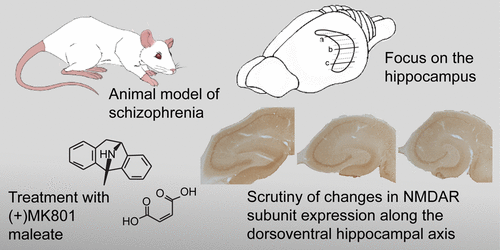当前位置:
X-MOL 学术
›
ACS Chem. Neurosci.
›
论文详情
Our official English website, www.x-mol.net, welcomes your
feedback! (Note: you will need to create a separate account there.)
Time-Dependent Alterations in the Expression of NMDA Receptor Subunits along the Dorsoventral Hippocampal Axis in an Animal Model of Nascent Psychosis.
ACS Chemical Neuroscience ( IF 4.1 ) Pub Date : 2018-04-10 , DOI: 10.1021/acschemneuro.8b00017 Valentyna Dubovyk , Denise Manahan-Vaughan
ACS Chemical Neuroscience ( IF 4.1 ) Pub Date : 2018-04-10 , DOI: 10.1021/acschemneuro.8b00017 Valentyna Dubovyk , Denise Manahan-Vaughan

|
Psychosis is a mental condition that is characterized by hallucinations, delusions, disordered thought, as well as socio-emotional and cognitive impairments. Once developed, it tends to progress into a chronic psychotic illness. Here, the duration of untreated psychosis plays a crucial role: the earlier the treatment begins, relative to the first episode of the disease, the better the patient's functional prognosis. To what extent the success of early interventions relate to progressive changes at the neurotransmitter receptor level is as yet unclear. In fact, very little is known as to how molecular changes develop, transform, and become established following the first psychotic event. One neurotransmitter receptor for which a specific role in psychosis has been discussed is the N-methyl-d-aspartate receptor (NMDAR). This receptor is especially important for information encoding in the hippocampus. The hippocampus is one of the loci of functional change in psychosis, to which a role in the pathophysiology of psychosis has been ascribed. Here, we examined whether changes in NMDAR subunit expression occur along the dorsoventral axis of the hippocampus 1 week and 3 months after systemic treatment with an NMDAR antagonist (MK801) that initiates a psychosis-like state in adult rats. We found early (1 week) upregulation of the GluN2B levels in the dorso-intermediate hippocampus and late (3 month) downregulation of GluN2A expression across the entire CA1 region. The ventral hippocampus did not exhibit subunit expression changes. These data suggest that a differing vulnerability of the hippocampal longitudinal axis may occur in response to MK801-treatment and provide a time-resolved view of the putative development of pathological changes of NMDAR subunit expression in the hippocampus that initiate with an emulated first episode and progress through to the chronic stabilization of a psychosis-like state in rodents.
中文翻译:

在初发性精神病动物模型中,沿腹侧海马轴NMDA受体亚单位表达的时间依赖性变化。
精神病是一种精神病,特征是幻觉,妄想,思维紊乱以及社会情感和认知障碍。一旦发展,它趋向于发展成慢性精神病。在这里,未治疗的精神病的持续时间起着至关重要的作用:相对于疾病的首发发作,治疗开始得越早,患者的功能预后就越好。尚不清楚早期干预的成功与神经递质受体水平的进行性改变相关的程度。实际上,人们对第一次精神病事件后分子变化如何发展,转化和建立的了解甚少。已经讨论了在精神病中具有特定作用的一种神经递质受体是N-甲基-d-天冬氨酸受体(NMDAR)。该受体对于海马中的信息编码特别重要。海马是精神病功能改变的场所之一,已将其归因于精神病的病理生理学中。在这里,我们检查了在成年大鼠中开始引起精神病样状态的NMDAR拮抗剂(MK801)全身治疗后1周和3个月,是否沿海马背腹轴发生NMDAR亚基表达的变化。我们发现在背侧中间海马体中,GluN2B的表达水平较早(1周)上调,而在整个CA1区域中,GluN2A表达的表达水平较晚(3个月)下调。腹侧海马没有表现出亚基表达变化。
更新日期:2018-04-10
中文翻译:

在初发性精神病动物模型中,沿腹侧海马轴NMDA受体亚单位表达的时间依赖性变化。
精神病是一种精神病,特征是幻觉,妄想,思维紊乱以及社会情感和认知障碍。一旦发展,它趋向于发展成慢性精神病。在这里,未治疗的精神病的持续时间起着至关重要的作用:相对于疾病的首发发作,治疗开始得越早,患者的功能预后就越好。尚不清楚早期干预的成功与神经递质受体水平的进行性改变相关的程度。实际上,人们对第一次精神病事件后分子变化如何发展,转化和建立的了解甚少。已经讨论了在精神病中具有特定作用的一种神经递质受体是N-甲基-d-天冬氨酸受体(NMDAR)。该受体对于海马中的信息编码特别重要。海马是精神病功能改变的场所之一,已将其归因于精神病的病理生理学中。在这里,我们检查了在成年大鼠中开始引起精神病样状态的NMDAR拮抗剂(MK801)全身治疗后1周和3个月,是否沿海马背腹轴发生NMDAR亚基表达的变化。我们发现在背侧中间海马体中,GluN2B的表达水平较早(1周)上调,而在整个CA1区域中,GluN2A表达的表达水平较晚(3个月)下调。腹侧海马没有表现出亚基表达变化。











































 京公网安备 11010802027423号
京公网安备 11010802027423号